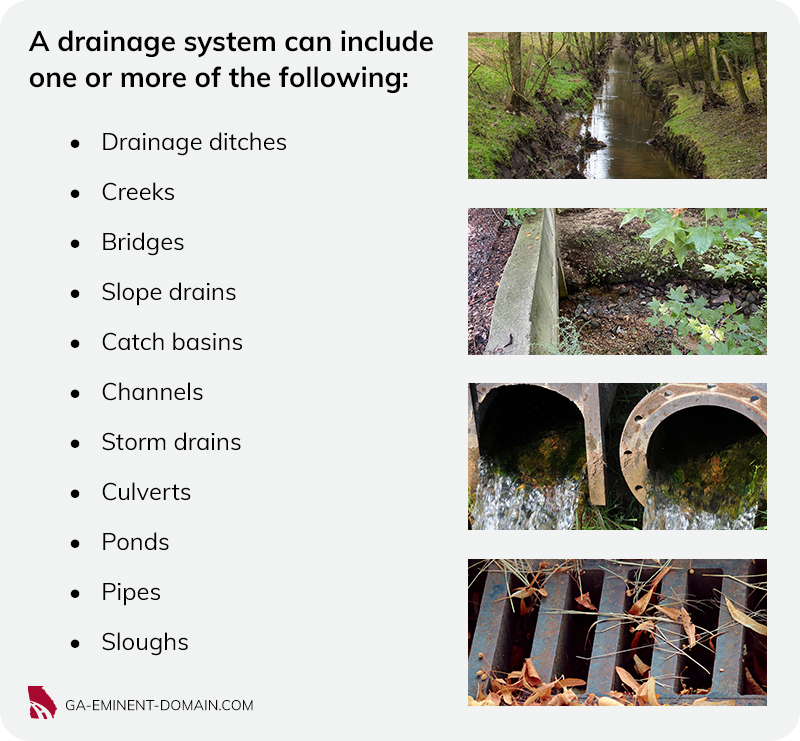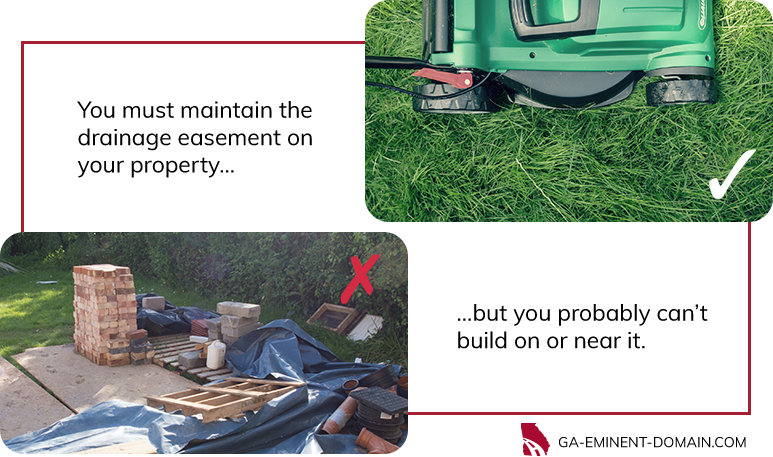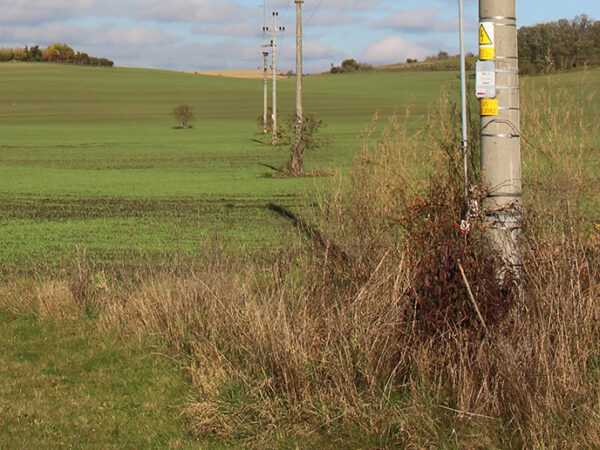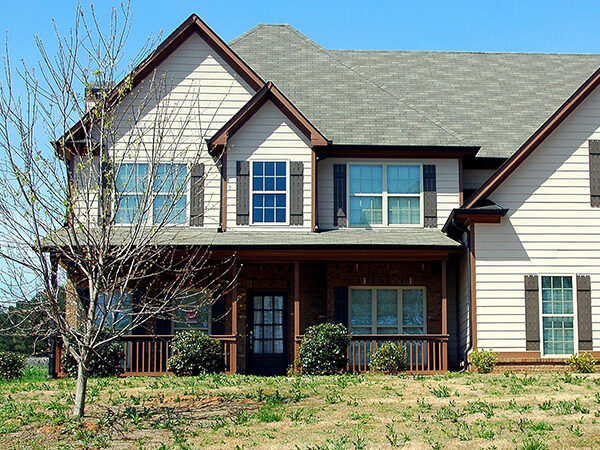Across my nearly two decades of practice as an attorney, my eminent domain clients have had many questions about easements and how they will affect their private property. In this article, I’ll discuss how drainage easements may impact your home or business, and what you can do if you have questions or concerns about one.
What is a drainage easement?
An easement is part of your land or property that the government or utility companies can access. A drainage easement can take the form of access to your drainage infrastructure, the right to access your property or properties, or both. This type of easement is attached to the property’s deed and is considered a permanent feature of the land. Without it, officials would not be able to address water-related problems in the community, such as storm water floods.
But the disruption to you can be significant.
What is the process for creating a drainage easement?
It can be very upsetting when the government decides to take your land for a drainage easement. Trying to prevent the easement is unlikely to be successful. However, your attorney can help you pursue the full value of your property, regardless of the government’s initial offer. Just because the government is taking a piece of your property, that doesn’t mean you have to take the first offer for it. In fact, you probably shouldn’t.
Here are the steps in the easement process:
- The government (or certain third parties) determines a need for a drainage easement on your property.
- The government determines the value of loss to your property due to the drainage easement.
- The government contacts you with an offer for your property which you do not have to accept.
- If you accept, the government pays you and you allow them to add the drainage easement to your deed along with the rights and obligations that come with it.
- If you decline, you then negotiate with the government to try to reach a compensation agreement that you believe more closely matches the fair value of your property.
- Note that you can withdraw and use the money from the government’s initial offer while you negotiate. The purpose of negotiations is to try to increase the amount you receive beyond the initial offer.
- The government gains the right to access the easement as soon as it makes this initial deposit.
- If you can’t agree on an amount, a judge can determine the value of your land loss and thus the compensation the government must pay for the drainage easement
What are my easement rights and obligations?
Both the property owner and the easement holder have a few things they can do, must do, and can’t do with your land.
What you can do
The drainage easement is still your property, and so you still have ownership of it despite the government’s right to access and use it. Easements are generally considered to be permanent parts of a property’s deed, so you can sell your land with the easement attached as long as you disclose it to potential buyers. You might also be able to landscape or build around the easement, but you’ll need the permission of the entity that holds the easement.
Any changes you make to your property must permit access to the easement and allow it to function normally to prevent flooding. For example, you may be able to build a driveway over underground pipes as long as it doesn’t interfere with the flow of water and allows utility workers to easily access them. However, you probably wouldn’t be able to plant trees along the driveway because the roots might eventually interfere with the pipes.
What you must do
Unfortunately, owning property with a drainage easement obligates you to perform certain duties to maintain it. This could include mowing, landscaping, and general repairs and maintenance to keep the easement area free of debris. The responsibility for maintaining drainage infrastructure falls to the property owner.
What you can’t do
Another consequence of drainage easements is that they restrict what you can do with your property. You cannot make improvements directly upon it or put up restrictions or barriers that interfere with its functioning. This usually means no fences, walls, or buildings on or around the easement that disrupt the flow of water.
Will a drainage easement affect the value of my property?
In many cases, drainage easements have little to no direct effect on a property’s actual value. However, the reality is that drainage easements can affect your property’s value indirectly depending on factors such as:
- Buyers’ perception – When you sell your property, it’s required that you disclose any easements that might be attached to it. Whether the easement affects property value or not, its presence might make buyers choose another option just so they don’t have to deal with it, especially if it requires regular maintenance.
- Difficulty getting a loan – Lenders could be concerned that a drainage easement might negatively affect the value of your property, either now or in the future. This could make them hesitant to give someone a loan to buy your house or land, or to give you one for remodeling.
- Insurance issues – As with lenders, insurers might perceive a potential problem with your property due to the presence of a drainage easement. As a result, the insurance company might demand higher homeowners’ insurance premiums or additional policies such as flood insurance for the property. Having to pay extra for insurance might also drive prospective buyers away.
- Tax implications – Unfortunately, even though a drainage easement isn’t completely under your control, you still own the land it’s on and have to pay taxes on it. However, you can negotiate tax responsibilities with the government when they make their initial offer for your property. Regardless, income from the sale of land with an easement is generally treated the same as income from the sale of land without one for tax purposes.
Learn More: Easement laws aren’t restricted to addressing drainage and flooding. In fact, there are many different types of easements that the government can place on your property.
What should I do if the government wants to put a drainage easement on my property?
The government is like any other consumer in that it wants the maximum value at the minimum cost for whatever it buys. When it begins the process of taking your land for a drainage easement, it will make you an offer that probably won’t amount to fair compensation relative to the actual value of your property. You’re under no obligation to accept this offer and can and should push back for what your property’s actual worth may be.
Some of the factors that may increase your easement compensation include:
- Obtaining a real estate appraisal showing that the government’s assessment of your property’s Fair Market Value (FMV) is too low.
- Relocation expenses the government hasn’t considered.
- Severance damages such as:
- The loss of a business’ ability to generate income.
- Devalued land when the government’s taking of a parcel makes the owner’s remaining land nonconforming with zoning laws.
- Loss of access to remaining parcels after a taking.
- Inefficient property divisions resulting from a taking.
Has the government notified you of an easement taking? We can help.
On average, our experienced eminent domain attorneys get our clients 3x their initial property offers.1 Our team has more than 90 years of combined experience fighting for our clients’ rights and trying to maximize their compensation.
Our firm was founded by attorneys who worked for a state Department of Transportation, but left because they felt property owners weren’t always being treated fairly in negotiations. Now, we represent property owners in eminent domain cases exclusively.
Call us at 1-888-391-1339 or contact us online today for a free case evaluation.




